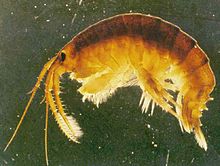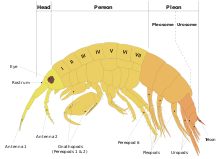Dikerogammarus villosus
| Dikerogammarus villosus | |
|---|---|

| |
| Scientific classification | |
| Domain: | Eukaryota |
| Kingdom: | Animalia |
| Phylum: | Arthropoda |
| Class: | Malacostraca |
| Superorder: | Peracarida |
| Order: | Amphipoda |
| Family: | Gammaridae |
| Genus: | Dikerogammarus |
| Species: | D. villosus
|
| Binomial name | |
| Dikerogammarus villosus (Sowinsky, 1894)
| |
Dikerogammarus villosus, also known as the killer shrimp,
Description

D. villosus can grow up to 30 millimetres (1.2 in) in length, relatively large for a freshwater
Distribution
D. villosus was originally found in the lower courses of large rivers in the
There are fears that it could spread to the
Ecology
In its natural range, D. villosus is not the most abundant species of amphipod and it does not behave as aggressively as it does in areas it has invaded.[6]
Habitat
D. villosus can colonise many types of
Feeding
D. villosus is
Growth and reproduction
D. villosus breeds all year round so long as the water temperature is above 13 °C (55 °F). When they mate, the female is carried on the ventral side of the male. Each pair produces an average of 27 eggs, but up to 50 eggs can be laid. The young animals become sexually mature in 4 to 8 weeks, once they are 6 mm in length and after moulting several times. They are fast-growing, during winter increasing by 1.3–2.9 mm in length per month and by 2.0–2.6 mm every two weeks in spring. Populations are predominantly female.[2][5]
Effects on other species
In the Netherlands, D. villosus is threatening the native amphipod species Gammarus duebeni, as well as Gammarus tigrinus which had previously become invasive after previously being introduced from North America.[13] It is thought to have displaced two other species of Dikerogammarus (D. bispinosus and D. haemobaphes) which were previously invasive in the Danube.[14] Its ability to attack and feed on a range of species could cause the local extinction of some species.[11]
References
- ^ S2CID 7996055.[permanent dead link]
- ^ a b c d e f g Danielle M. Crosnier; Daniel P. Molloy (October 2006). "Killer Shrimp - Dikerogammarus villosus" (PDF). Aquatic Nuisance Species Research Program. United States Army Corps of Engineers. Archived from the original (PDF) on December 29, 2009. Retrieved September 9, 2010.
- .
- ^ a b c "Alien 'killer' shrimp found in UK". BBC News. September 9, 2010. Retrieved September 9, 2010.
- ^ a b c Simon Devin; Jean-Nicolas Beisel (November 16, 2006). "Dikerogammarus villosus" (PDF). Delivering Invasive Alien Species Inventories for Europe. Archived from the original (PDF) on October 1, 2013. Retrieved September 9, 2010.
- ^ S2CID 83475733. Archived from the original(PDF) on 2012-03-12. Retrieved 2010-09-09.
- BBC Wales. November 29, 2010. Retrieved December 1, 2010.
- ^ "Ny invasiv art upptäckt i Vättern". March 8, 2023. Retrieved March 8, 2023.
- . Retrieved 25 February 2021.
- PMID 32355455.
- ^ a b Paul Brown (January 3, 2001). "'Killer shrimp' threatens native species in Britain's rivers". The Guardian. Retrieved September 9, 2010.
- .
- PMID 10874746.
- .
External links
- Species Profile - Killer Shrimp (Dikerogammarus villosus), National Invasive Species Information Center, United States National Agricultural Library.
- Invasive Species Compendium, CAB International
